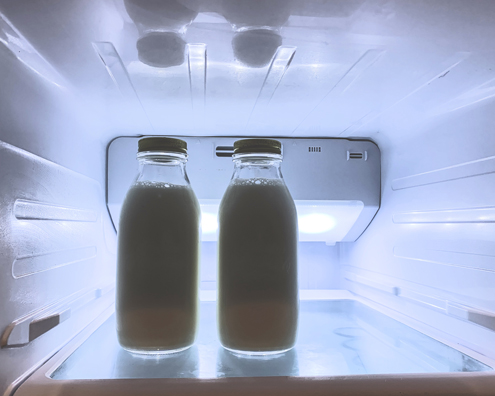‘So what precisely is kefir?’ I don’t hear you ask. Well according to the top boffins here at Laboratoires Yumblog, kefir is a scientifically proven magic drink packed full of friendly bacteria so affable they’ll transform your stomach into a fragrant wonderland of probiotic loveliness. ‘Hmm, sounds interesting’ you quizzically reply, ‘but by what devilish witchcraft does one contrive this unholy catholicon?’
It couldn’t be easier – scroll down past the books and milk bottle, click ‘Read more’, utter your favourite incantation, click your heels together three times and prepare to enter the mystical world of kefir.
Preparation time: 10 minutes plus 2 days to ferment
Cooking time: 0 minutes
Skill level: easy
Ingredients
- Packet of Organic Premium Milk Kefir grains – 10 g – available from happykombucha.co.uk
- Full fat milk – 500 ml
Equipment
- 1 litre Kilner jar (or similar)
- Sieve (metal is fine)
- Bowl (sieve sized)
- Container to store your kefir (we use a 500ml Kilner jar)
Place your kefir grains in the 1 litre Kilner jar (we nominally sterilised ours with boiling water, but I’m not sure this is essential) and pour over the milk. Seal the lid and leave at room temperature for 48 hours.
After 2 days your kefir should be a bit lumpy and possibly separated.
Place the sieve over the bowl and pour in the kefir. Gently shake the sieve to strain the liquid. You should be left with a thin yoghurty liquid in the bowl and some lumpy cottage cheese-like grains in the sieve.
Pour the liquid into your storage container and put in the fridge. Gently return the grains to the original jar (I cleaned and sterilised first, but again I don’t think this is essential) and add 500ml of full fat milk.
Repeat this process for ever and ever.
FYI: If going away on holiday, or in a coma, kefir grains can be kept alive in the fridge for two weeks.*
Verdict: Incredibly easy to make. The end result looks, smells and no doubt tastes like baby sick, but don’t let that put you off … persevere and you might even begin to enjoy this slightly fizzy and worryingly cheesy drink.
Other milk-heavy recipes include this simple and lively yoghurt or if you fancy something a little more eggy and noggy, this Egg Nog.
Drink: It is itself a drink which can be ‘enjoyed’ au naturel or mixed with fruit to make it a less challenging and more palatable experience.
Entertainment: Watching this once decent country rapidly descend into a hate-filled right-wing dystopia. And Worzel Gummidge.
* Sad Addendum (Saddendum)
Tragically due to a prolonged bout of a flu-like-symptom-winter-cold-thing-disorder and subsequent delicate-tummy-dyspepsia-syndrome I wasn’t particularity craving fizzy cheese drink and as a result the kefir was left neglected and unloved for several weeks and alas dear reader(s), sadly passed away. My co-blogger has subsequently told me that since I’ve proved incapable of looking after a bacterium, I am unfit to be a pet owner and as a result my pleas for a hamster have been declined.




Excellent, I’ve missed the high level sarcasm of yesteryear. Kefir also good to guard against urinary tract infections, but perhaps I should keep my wee issues to myself.
Ha – the eggnog recipe!
Remember reading that when you first posted it; I’ve been coming back it annually ever since. Though I suppose eggs can be nogged any time of year as well as at Christmas.
For some reason the skill level:
‘few things in life are easier than nogging an egg’ always brings a smile.
Thanks Sam, always nice to bring a smile.